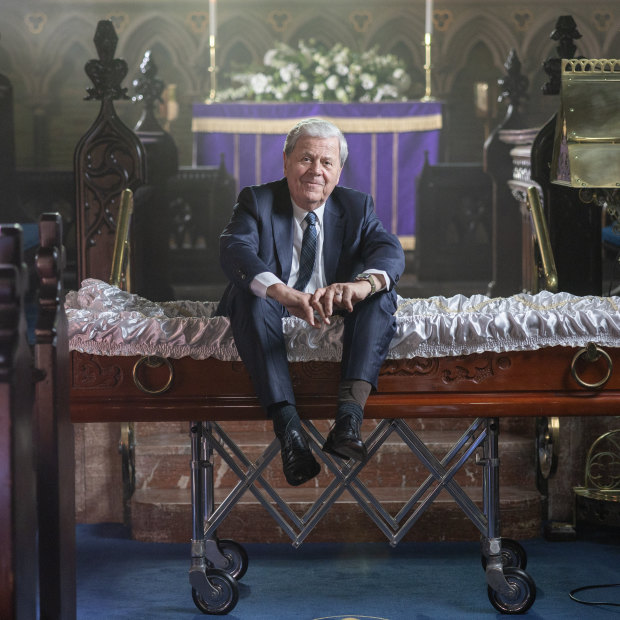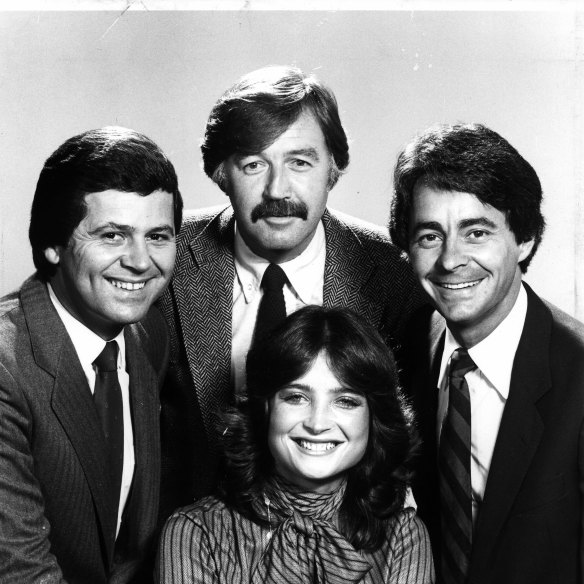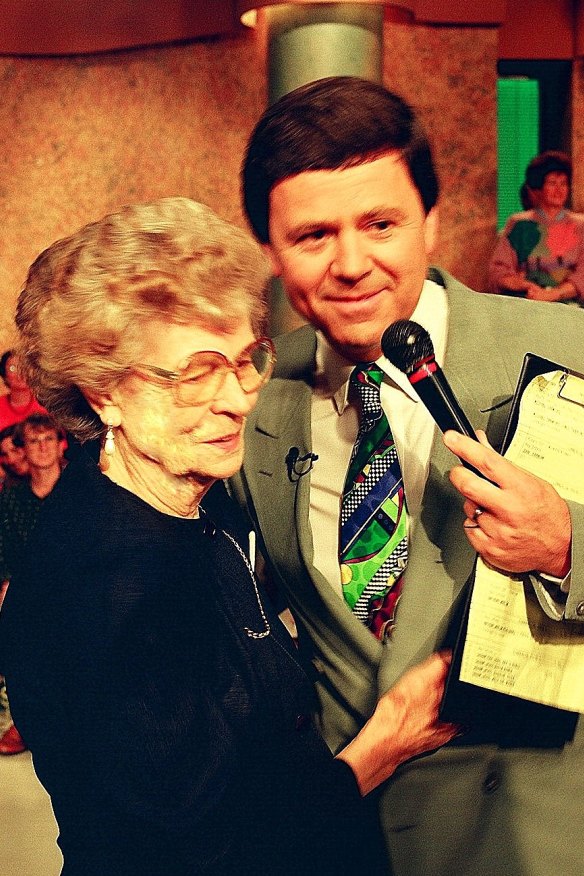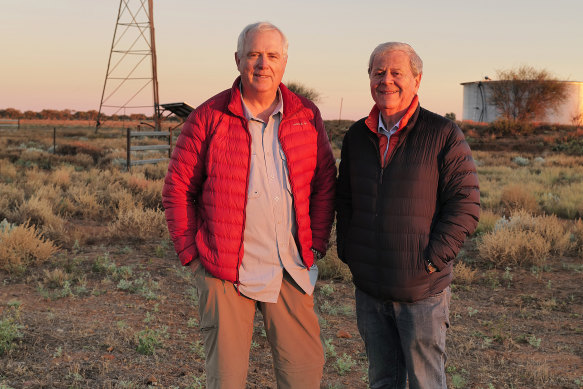This was published 10 months ago
‘To a certain extent, I’ve been in denial’: Ray Martin on life’s great mystery
From 60 Minutes to Logie awards and Midday, Ray Martin climbed to the pinnacle of Australian TV journalism. What was left to do? Explore life’s ultimate - and ultimately unsolvable - mystery.
By Tim Elliott

Ray Martin: “I’m at the stage where I only do the things that I absolutely love.”Credit: Courtesy of SBS
Ray Martin is 79 years old. He’s a good 79; sharp, curious; still got all his hair and teeth. Still, he’s 79. The life expectancy for men today in Australia is 81.2, which means that, statistically speaking, he’s approaching the finish line. And yet death is still an abstraction for him; he hasn’t talked to his wife or two kids about what he wants to happen at his funeral, how he would like to be buried, who should speak and what music to play. This is understandable; he’s been pretty busy. But death waits for no man, even a five-time Gold Logie winner.
“I know,” he says, when we meet one afternoon in Sydney’s north. “But I’ve just never thought about death. I was like, it happens to someone else! To a certain extent, I’ve been in denial.”
He would probably have remained in denial if not for the BBC, which approached him, in late 2022, with an offer to take part in a television series about death. (The series begins on SBS on August 14.) “I’m at the stage where I only do the things that I absolutely love,” he says. “And death is life’s great mystery. Clearly, the eternal question is what happens after you die.”
If ever there was a topic worthy of Martin’s gaze, then, this was it. It might also, as he points out to viewers in the series, help him come to terms with his own mortality, and even give him some tips for his own funeral.
The program, a three-part series called Ray Martin: The Last Goodbye, is part experiential journey, part social history, an exploration of how different cultures deal with death and seek meaning in the inevitable. This is, if you’ll pardon the expression, very much a live question. Baby Boomers are Australia’s largest demographic and they will, by the end of the decade, be reaching the end of their life cycles, ushering in what some have dubbed “peak death”.
But the way we say goodbye to the Boomers is not the way they said goodbye to their parents and grandparents. When Martin’s grandmother died, for instance, her body was prepared by the family at home: the kids were invited to look at her in the parlour and touch her. (Not for nothing are funeral homes sometimes called “funeral parlours”.) But these days, most people die in hospitals or nursing homes, and body viewings are increasingly rare. As a result, we’ve become fairly distanced from death. Indeed, the whole funeral industry is predicated on our determination to avoid it; too squeamish or bereaved, we retreat to genteelisms, outsourcing our final journey to places like White Lady and Living Hope.
Yet others remain more hands on, as this series attests. Viewers witness a Muslim body-washing ritual, when family members of the deceased wash their late loved one with soap and water. Some of the most affecting scenes involve the Espejels, an Australian-Mexican family celebrating the Day of the Dead, where the dearly departed are welcomed back to the land of the living, just for a night. There are offerings of food and incense, and a rambunctious communal meal. It’s an intergenerational affair, moving but not maudlin. At the end of the evening, Diego, the epically mustachioed paterfamilias, strums a plangent ranchera on his guitar while the family dog dines on leftovers.
Martin is a poignant choice for host. There’s a moment in the first episode where we see a man, shot from behind, at a distance, walking along a footpath in Holbrook, southern NSW, site of the southern hemisphere’s first cryogenic facility. He moves a little stiffly and is bent slightly forward at the hips, as if dragging an invisible sled. Just for a moment I thought, “Who’s that old man?” before realising, “Wow, that’s Ray.”
I was a little nervous about meeting Martin, but I needn’t have worried. Real Ray is almost exactly the same as Screen Ray. There’s the avuncularity, the homeliness. There’s the deathless helmet of tastefully barbered hair. But most of all there’s that voice, surely one of the most familiar to Australian TV viewers, as agreeable as a strong milky coffee or good shiraz, oaky and resonant, with base notes of self-deprecation and daggyness, and a lightly worn authority that hovers between the platitudinous and the profound. It’s a lot to take in, but it’s never overwhelming. It’s just Ray.
“Ray says ‘yes’ to life,” says comedian and friend Gretel Killeen, who regularly appeared with Martin on Midday with Ray Martin in the late 1980s and early 1990s. “Ray’s a unique human. He’s smart, curious and adventurous, and yet he has an ‘everyman’ quality that makes people feel at ease in his company.”
The youngest of four kids, Martin grew up in an Irish-Catholic family in country NSW. His father was an engineer, and an alcoholic who regularly beat his wife; one of Martin’s earliest memories is of him and his mother running into the back paddock to escape his rifle-wielding father. (Martin was six.)
After finishing school in Tasmania, he got a Commonwealth scholarship to the University of Sydney, where he studied English and history. In 1965, he began working for the ABC, in Sydney. He’d only been there for four years when the ABC made him its New York correspondent. “I thought, ‘I’ve won the lucky dip,’ ” he says.

The 1982 60 Minutes team: From left, Ray Martin, George Negus, Jana Wendt and Ian Leslie.Credit: Channel 9
In 1978, he returned to launch a local version of the current affairs program 60 Minutes for the Nine Network. The job cemented his reputation as a reporter and made him a household name. With his enviable news sense and ease in front of the camera – the furrowed brow, those labrador eyes – he went on to forge an almost umbilical relationship with Middle Australia, hosting a series of marquee programs on Channel Nine, including Midday, several Logies Awards and federal and state election coverages.
From the mid-1990s to early 2000s he did two stints as host of the nightly news program A Current Affair. In 2005, shortly after bailing from Nine altogether, he delivered the Andrew Olle Media Lecture, at which he bemoaned the “dumbing down” of journalism.
The media has endured more convulsions since then, with mixed results. Martin loves the bottomlessness of the internet, being able to find virtually any piece of information he wants, when he wants. And today’s young journalists astound him. “They are smarter and better educated than I was.”
‘I know too many people, way smarter than me, who believe in God and the afterlife.’
Ray Martin
But he is variously appalled and terrified by the advent of fake news and AI, which have vaporised attention spans and bred extravagant levels of vitriol.
“Opinions you wouldn’t listen to in a pub are now plastered across social media,” he says. Such anomie is unpicking the social fabric one hateful tweet at a time, and flattening the public discourse. “Look at The Voice referendum,” he says. “Dutton’s phrase, ‘If you don’t know, vote no’ was an endorsement of ignorance. What you tell your kids is, if you don’t know, find out.”
The former gatekeepers, the commercial broadcasters, are now battling for relevance. “The networks don’t do any serious journalism. SBS and the ABC do, but the networks don’t. They prefer [The] Farmer Wants a Wife. There’s no way back now.” Not that it appears to matter. “My kids don’t watch commercial TV or read newspapers, and they are as informed as me.”

Martin with his mum on the final Midday Show.Credit: Courtesy of Ray Martin
“Ray and I are always having conversations about God,” says landscape photographer and close friend Ken Duncan, who met Martin on Midday and bonded with him over photography. (Sunsets are Martin’s favourite: he’s shot more than 4000 of them.) “I’m a firm believer in the spirit realm,” Duncan says. “I think Earth is a training ground for something more.” Martin is not so sure. “One of my favourite sayings is ‘Life is not a dress rehearsal,’ ” he tells me.

Martin with friend Ken Duncan.Credit: Courtesy of Ray Martin
And yet when it comes to the hereafter, he’s become increasingly agnostic. “I know too many intelligent people, way smarter than me, Rabbis to Jesuit priests, who believe in God and the afterlife,” he says. “And it’s the ultimate arrogance to say they’re wrong and I’m right.”
I ask him whether he’s made any decisions about his own funeral, but he’s coy. “The cryogenic freezing creeped me out, and the idea of being burnt or buried under five-and-a-half tonnes of soil isn’t great.” He says “the warmest” ceremony he saw during the making of the show was the Muslim body-washing, but that environmentally speaking, body composting seems the most attractive option.
In any case, he’s still got time on the clock. His mother lived to 87, and his great-grandmother lived to 104. He says he has more to do, and he doesn’t necessarily mean journalism. “With my adult children, I’m still here to help them, if I can. And I think of my two grandkids and I want to see them grow up. There’s certainly a lot to live for.”
To read more from Good Weekend magazine, visit our page at The Sydney Morning Herald, The Age and Brisbane Times.